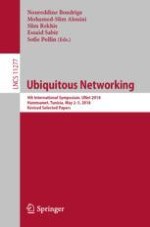2018 | Book
Ubiquitous Networking
4th International Symposium, UNet 2018, Hammamet, Tunisia, May 2 – 5, 2018, Revised Selected Papers
Editors: Noureddine Boudriga, Prof. Dr. Mohamed-Slim Alouini, Slim Rekhis, Prof. Dr. Essaid Sabir, Sofie Pollin
Publisher: Springer International Publishing
Book Series : Lecture Notes in Computer Science
